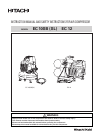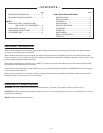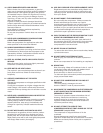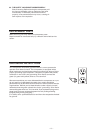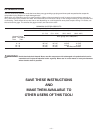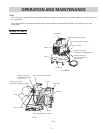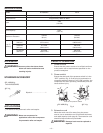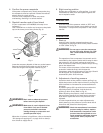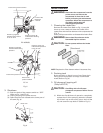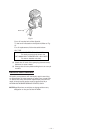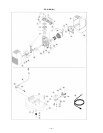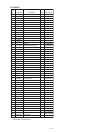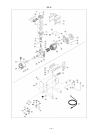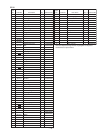
— 3 —
SAFETY
IMPORTANT SAFETY INSTRUCTIONS
FOR USE OF THE COMPRESSOR
WARNING:
Death or serious bodily injury could result from improper or unsafe use of compressor.
To avoid these risks, follow these basic safety instructions:
READ ALL INSTRUCTIONS
1. NEVER TOUCH MOVING PARTS.
Never place your hands, fingers or other body parts
near the compressor’s moving parts.
Never insert your fingers or other objects into the
housing's ventilator. Such an action invites the danger
of injuries or electric shocks.
2. NEVER OPERATE WITHOUT ALL GUARDS IN PLACE.
Never operate this compressor without all guards or
safety features in place and in proper working order. If
maintenance or servicing requires the removal of a
guard or safety features, be sure to replace the guard
or safety features before resuming operation of the
compressor.
3. ALWAYS WEAR PROTECTION.
Risk of injury. Always wear ANSI Z87.1 safety glasses
or equivalent eye protection. Compressed air must
never be aimed at anyone or any part of the body.Use
ear protection as air flow noise is loud when draining.
4. PROTECT YOURSELF AGAINST ELECTRIC SHOCK.
Prevent body contact with grounded surfaces such as
pipes, radiators, ranges and refrigeration enclosures.
This compressor must be properly grounded. Never
operate the compressor in damp or wet locations.
To reduce risk of electric shock, do not remove cover.
5. DISCONNECT THE COMPRESSOR.
Always disconnect the compressor from the power
source and remove the compressed air from the air
tank before servicing, inspecting, maintaining,
cleaning, replacing or checking any parts.
6. AVOID UNINTENTIONAL STARTING.
Do not carry the compressor while it is connected to
its power source or when the air tank is filled with
compressed air. Be sure the knob of the pressure
switch in the “OFF” position before connecting the
compressor to its power source.
7. STORE COMPRESSOR PROPERLY.
When not in use, the compressor should be stored in
indoor dry place. Keep out of reach of children. Lock-
out the storage area.
8. KEEP WORK AREA CLEAN.
Cluttered areas invite injuries. Clear all work areas of
unnecessary tools, debris, furniture, etc.
9. CONSIDER WORK AREA ENVIRONMENT.
Risk of electric shock. Don’t expose compressor to
rain. Don’t use compressor in damp or wet locations.
Keep work area well lit and well ventilated.
Risk of fire or explosion. Do not carry and operate the
compressor or any other electrical device near the
spray area. Don’t use compressor in the presence of
flammable liquids or gases.
Compressor produces sparks during operation. Never
use compressor in sites containing lacquer, paint,
benzine, thinner, gasoline, gases, adhesive agents,
and other materials which are combustible or
explosive.
10. KEEP CHILDREN AWAY.
Do not let visitors contact compressor extension cord.
All visitors should be kept safely away from work
area.
11. DRESS PROPERLY.
Do not wear loose clothing or jewelry. They can be
caught in moving parts.
Wear protective hair covering to contain long hair.
12. DON’T ABUSE CORD.
Never yank it to disconnect from receptacle.
Keep cord from heat, oil and sharp edges.
.
13. MAINTAIN COMPRESSOR WITH CARE.
Follow instructions for lubricating.
Inspect cords periodically and if damaged, have
repaired by authorized service center. Inspect
extension cords periodically and replace if damaged.
14. OUTDOOR USE EXTENSION CORDS.
When compressor in used outdoors, use only
extension cords intended for use outdoors and so
marked.
15. STAY ALERT.
Watch what you are doing. Use common sense. Do
not operate compressor when you are tired.
Compressor should never be used by you if you are
under the influence of alcohol, drugs or medication
that makes you drowsy.



